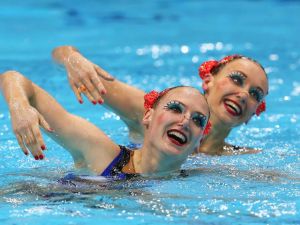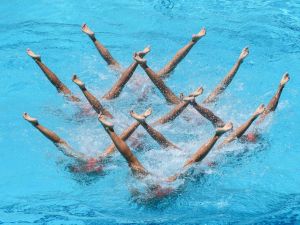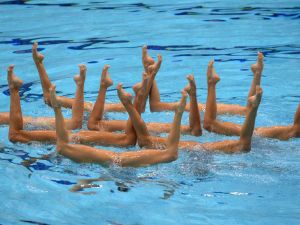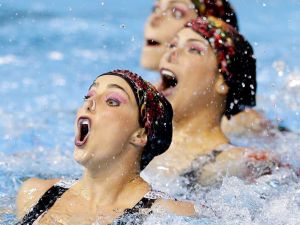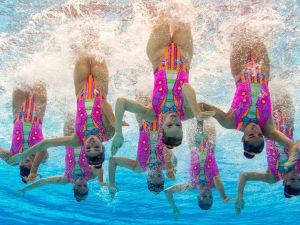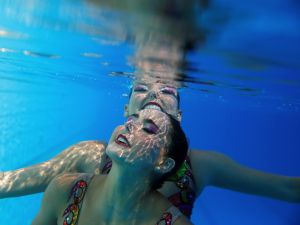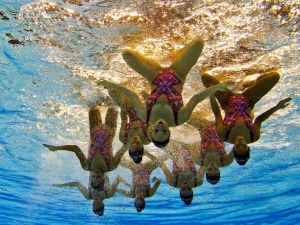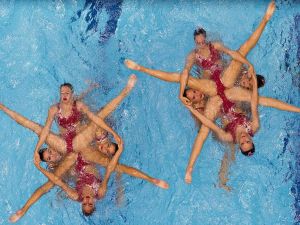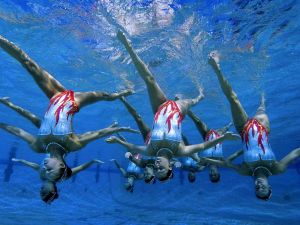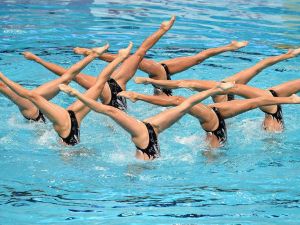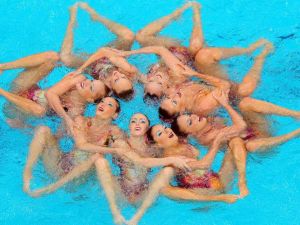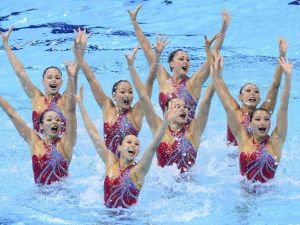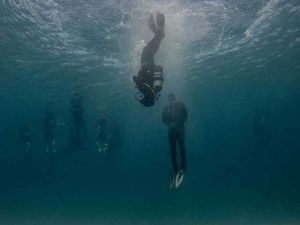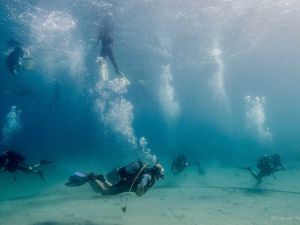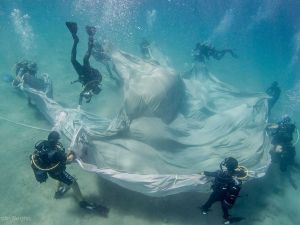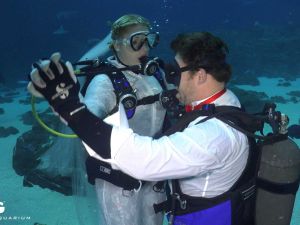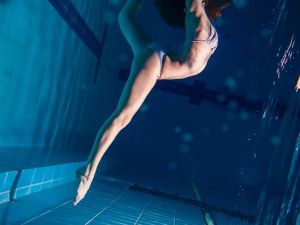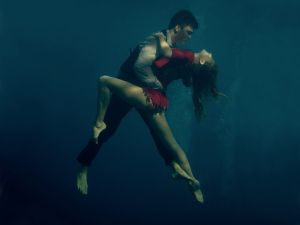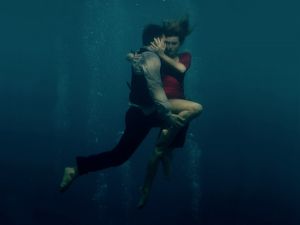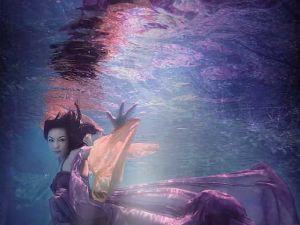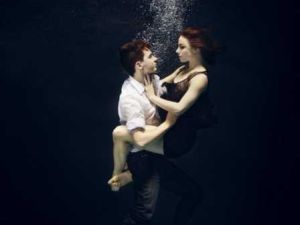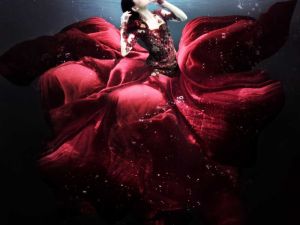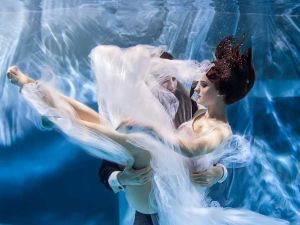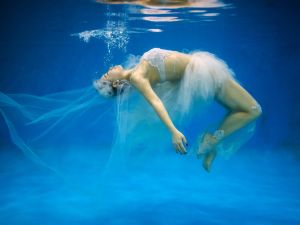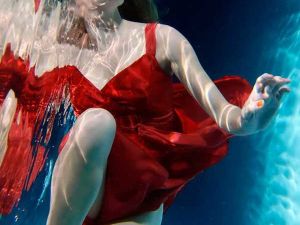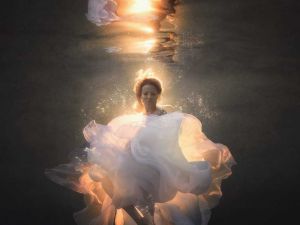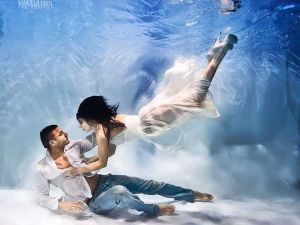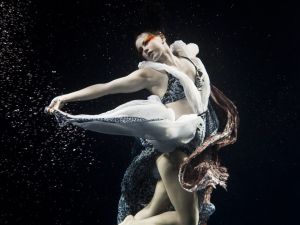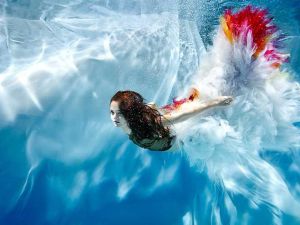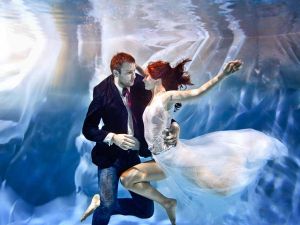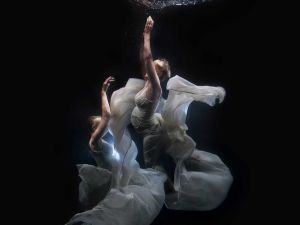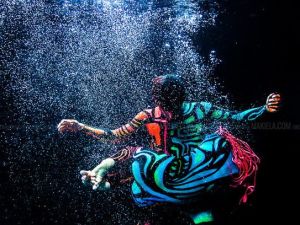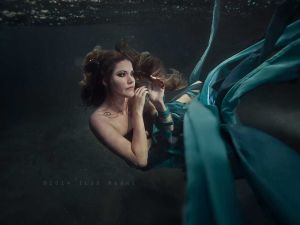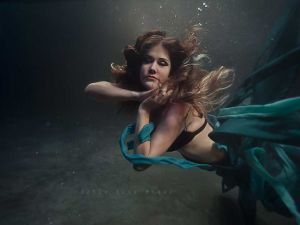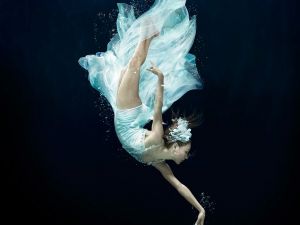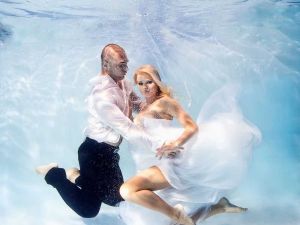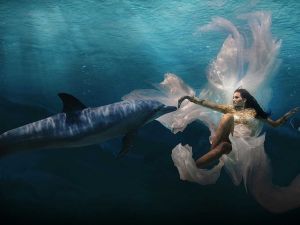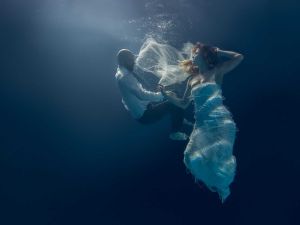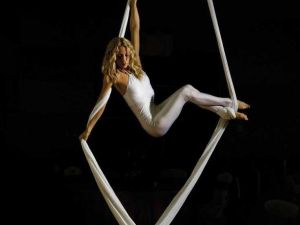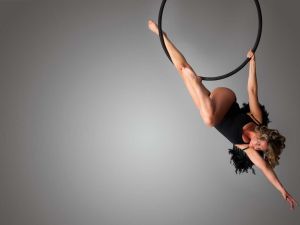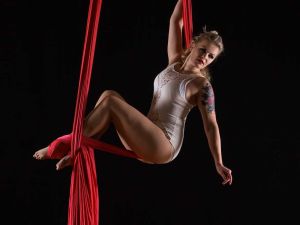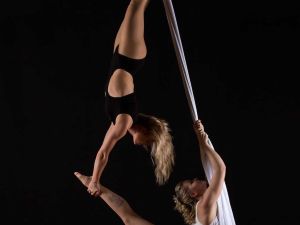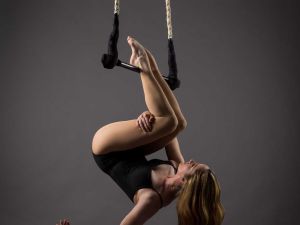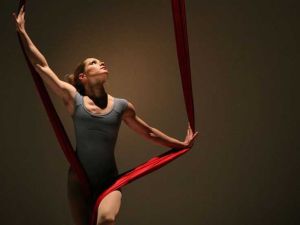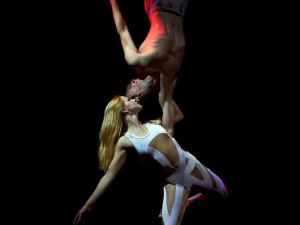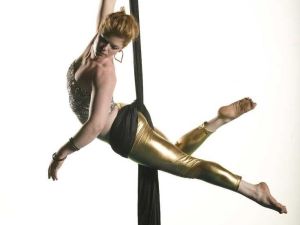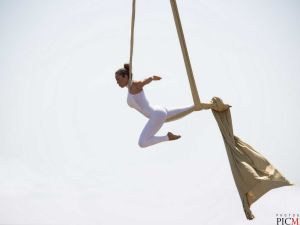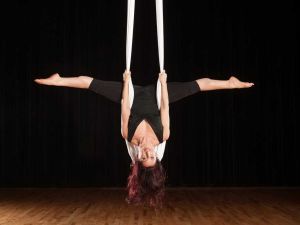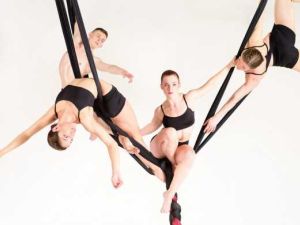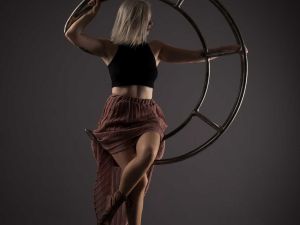
Unusual Dancing Environments: Underwater, Air and Space
Dance choreographers are the creators of dance, they always searched for new forms, moves, dance figures and elements to enrich the performance, make it unique and add something new and special. They try to expose the nature of dance, uncover its beauty and further develop it as art. This work involves different experiments, some of them can be successful, others may not be accepted by the public. One of such experiments involves transferring the dance outside the atmosphere of Earth.
Dancing in the Water and Underwater

Probably the first experiment of all others in this area was to put the dancers into the water. Water and air are physically different mediums with different viscosity. Standard dance moves that can be easily performed at dance floor, generally can’t be repeated in the same way in the water. Water immobilizes moves and slows them down, and requires more practice to work with balance and body control. There’s a plenty of room for everybody to work here: adaptation of dance figures and invention of new ones for choreographers, designing new costumes and solving issues with dress, costumes, hair and make-up for stylists, developing new dance practice and water training programs for dance teachers, technical issues related to searching of best angle of view and recording equipment for the camera crew, etc. And of course, dancing in the water requires more physical efforts and stamina from the dancers. One of the benefits of water dancing is that it’s less injury-prone than regular dancing on the floor. It’s also one of the reasons why water physical training programs became popular and are available in many gyms and swimming pools. Please, take a look at dance classes for adults beginners at our school if you're interested in classical dancing.
Synchronized Swimming
In spite of its name, actually it’s a kind of a dance show. It’s called swimming, because a performer must have strong swimming skills. This event was added to Olympic Sports in 1984 (Los Angeles, California, USA) and is the only event of Olympic Games where only female performers are permitted. Initially this type of competition included duet and team events only, but in past games, there was also a solo event.
The concept of synchronized swimming may sound crazy and absurd, because the performers obliged to stay upside down, so that most of the time only their legs are visible above the water. The legs play the most important role in the show and do various figures. It’s extremely difficult to reach equilibrium in the “bottom up” position, hold the breath, and follow the rhythm of music (especially because of reduced hearing caused by ear plugs to prevent ingress of water into the auricle). Besides, as the name suggests, the main rule here is the synchronism, when each member of the crew must move simultaneously. It’s really a tough work of the coach that can train and achieve such level of understanding between the crew members which is close to telepathy that allows them all to perform ideally as one.
Coaching is the most difficult part here. Because it’s not obvious how the coach can give commands and communicate with the team when they can’t see him and hear his voice. Only recent technologies offer wireless water proof voice transmitters and receivers that can work under the water. Now we can only imagine what tricks and secret techniques the coaches had to use earlier at the dawn of synchronized swimming.
The performance is filmed and should be viewed above the water. I guess many people were curios what happens under the water, because generally such scenes are considered to be backstage and are not usually televised. We give you a peek on the video below.
Pole Dance
Underwater pole dance is a more recent trend than synchronized swimming. It has standard pole dance moves adapted to be performed under the water. Performers can be male, female or couples of any sex and can wear different dress from swimsuits and bikinis to long and short gowns. Water has the ability to sway and wave the clothes which looks attractive on camera. So, sometimes, the performers wrap around long cloth and use it instead of dress as a more attractive underwater outfit. Ladies can be barefoot or wear high-heel shoes which will probably get damaged by water. But who cares? Beauty requires sacrifice!
Idea of pole dancing under the water is brilliant and is probably one of the most successful. The main reason is the pole put under the water which gives lots of benefits for the performer: it helps to gain a better control of the body, can be used as support point for floating up and down and for changing directions of the moves, to keep oneself on the same depth, easier achieve balance and fix position of the body to do more complicated figures. The vertical pole technically is a wonderful tool that allows to do various dance moves, not just the classic pole dance moves. Besides, the moves from standard pole dance look also very beautiful underwater.
The growing world-wide popularity of pole dance – a very athletic, artistic, recreational and fitness activity both for women and men, may also develop as underwater sport or dance art. Many dance schools and dance studios offer pole dance lessons, but they usually lack the required equipment and facilities such as swimming pool to give underwater classes. But demand creates supply, so who knows may be underwater pole dance as activity will be available everywhere in the near future.
Diving Dance
This activity assumes using scuba, so that the performers can comfortably stay under the water for a long period of time. The dance show is performed by performers who have diving skills. Aqualung can be simple just mask and gas tank with compressed air, or a full body suit. Usually it depends on the depth and temperature of water. The only and the most serious disadvantage of diving suite is its ugly gloomy appearance. All the hoses, gauges, wetsuits, fins and masks seem more like a military Navy special forces mission rather than ballerinas show. The idea to decorate the suite also fails and doesn’t give any improvements. But lovers of techno and postapocalyptic styles will like and accept it as it is.
The scuba diving format is being applied by fans for different events: birthday parties, celebration of holidays and even weddings. Now the dance show is also one of them. The audience should also have diving skills in order to book the tickets and attend the event. They can view the show live under the water.
On of such projects is called “Drops of Breath” where 14 dancers make underwater performance at a depth of about 5 meters in Cape Sounion, southeast of Athens, Greece, beneath the ancient temple of Poseidon - the god of the sea in classical mythology. When the water is clear, 40 seats are available for the audience on the seabed, and 40 more could get a panoramic view as they snorkel while landlubbers can watch nearby on a giant screen. The performance is the brainchild of Greek choreographer Apostolia Papadamaki and French choreographer Sophie Bulbulyan, whose dance group in one of Paris' poorest neighborhoods includes disabled dancers. Composer Trifonas Koutsourelis researched and tested the transmission of sound frequencies so his score could both be heard clearly and choreographed in water, where movement slows down.
Photo Art
A special category of underwater dances is the photo art which is designed and created by photographers, not choreographers. The result is presented in attractive images, usually with photo corrections, compilations and photomontage in Photoshop and similar software. It allows to achieve amazing effects and fantastic photos that generally can’t be purely captured in reality. Besides, it gives freedom for imagination and creativity by using professional models instead of dancers during the photoshoot. The models are familiar with the camera and know how to better present themselves. All these factors can lead to very successful results.
The idea of photo art can be different, but usually it is related with one of the following topics:
- Imitation of a real dance, e.g. Ballroom or Latin-American dances such as Tango, Waltz or Salsa performed by a couple underwater.
- Solo dance, usually of Ballet style.
- Fantasy, usually dance with underwater creates, such as dolphins, turtles and even sharks. Sometimes in this case a model plays a role of mermaid or water-nymph with a fishtail.
- Underwater fashion photography, which is devoted to displaying clothing and other fashion items in underwater environment. The models can do simple poses that can remind some dance figures, but the main aim of these photos is to emphasize fashion, style and glamour.
Some people can consider such approach to be unnatural, because the models don’t actually dance, but try to assume a correct pose. However, the resulting photos are quite impressive. The most famous underwater photographers are Brett Stanley, Ilse Moore, Rafal Makeila, Kenvin Pinardy and Katerina Bodrunova. We selected some underwater photos below.
The Air Dances

From ancient times people dreamed to fly as birds in the sky. Modern technologies made it reality. Choreographers also have the desire to follow the path of air and perform amazing dances by overcoming the force of gravity. Below we will list the most successful air dancing experiments.
Aerial Dance
Aerial modern dance is a sub-genre of modern dance first recognized in the United States in the 1970's. The performers use special gear which is attached to the ceiling and allows to stay in the air and move in space in three-dimensions. The ability to incorporate vertical, as well as horizontal movement paths, allows for innovations in choreography and movement vocabulary.
The gear usually includes low-flying trapeze (dance trapeze), aerial hammock, silks, and lyra (also known as aerial hoop, aerial ring or cerceaux) – which is also used in gymnastics and circus. All of them can have different colors to match the design of scene and background decorations.
The aerial dance can be performed in pairs, as an ensemble or as a solo. Usually different types of gear are used in a single performance that allow to extend the dance figures and make it more complicated and spectacular. Each gear is unique and different by how the dancer can balance, center, change its orientation and move (swing, rotate, slide and float in the air).
Today many dance schools offer aerial dance classes. It develops strength, stamina and flexibility, reaction, dexterity and coordination. Some fitness centers also use the gear in their training programs, because they offer a good complex of physical workout on different muscles of the body.
Skydiving Dance
Skydiving or parachuting is a method of transiting from a high point (usually from plane or high buildings) to the ground with the use of a parachute. It has free-fall phase, a time during which the parachute has not been deployed and the skydiver can perform various moves or figures. Experienced freestyle skydiver can perform difficult figures in the air, including acrobatic and athletic body movements that imitate some kind of contemporary dancing. This kind of activity can be considered as extreme or stunt. It requires lots of practice in indoor wind tunnel facilities and hundreds of standard jumps before a skydiver can master the freestyle moves. The problems that skydivers face are similar to those that underwater dancers have: keep the balance, reposition of body in space using air drag. Besides, the time to perform the freestyle moves is very limited, so the performer must do everything very quickly. Air dancing is very rare, it’s a pioneer field, there are no instructors that can teach you this. So skydiving enthusiasts have to try and test different things by themselves in order to achieve the desired results. Below are some videos of skydiving dancing.
The Outer Space Dances

In the age of space and technology we have private companies such as SpaceX that build space ships to make the exploration of cosmos cheaper and make the space travels more affordable. Still it’s extremely expensive, but the brave new world is near and the future may bring many amazing things such as new principles and styles of dancing Tango on Mars or Moon.
Anyway, using knowledge of physics and facts gathered from space research missions we can peek in the future and make plausible hypothesis how space dances can look like and what to expect. First of all, the space dances can be divided into 3 categories:
- Dance in the open space. This type of dance is performed outside the space craft. Many astronauts have already been outside the space ship, being always connected with it using cable as security measure. This kind of dance make look similar to underwater dance with scuba, but the difference is huge. There is no friction in space, so that the impulse of the body can’t be naturally discharged. It means, that it’s almost impossible to change the orientation of body or the movement velocity without additional equipment such as compact maneuver engines located on the space suit. The cable is also used as a rope by astronauts to drug themselves closer to the ship. The main skill of the performer will be coordination, because physical skills are not required here. The space suits for outer space are quite massive, because the need to protect from freezing low temperature, small space garbage and contains tanks with air and engines to maneuver. So the dancer in such suite looks very funny and clumsy. Besides, such performance is quite extreme, because who know what is waiting there in the darkness of space?
- Dance inside a space station or ship. This time of dance is probably the safest and promising. The dancers can do arbitrary moves and push of from the walls to change the directions. The ship has air and normal temperature inside, so the dancers can use beautiful clothes and fancy dresses. The interior of modern space ships is very compact, probably in the future they will have special space ballroom studios as dedicated spaceship module.
- Dance on other planets. Everybody knows the Moon Walk of Michael Jackson. Probably one day it can be performed literally on the surface of natural satellite of Earth. The Moon and Mars are smaller than Earth, so they have lower gravity. It helps to make high jumps easily, and perform break dance elements physically easy. Probably modern and street dances are the most suitable and adapted for space.
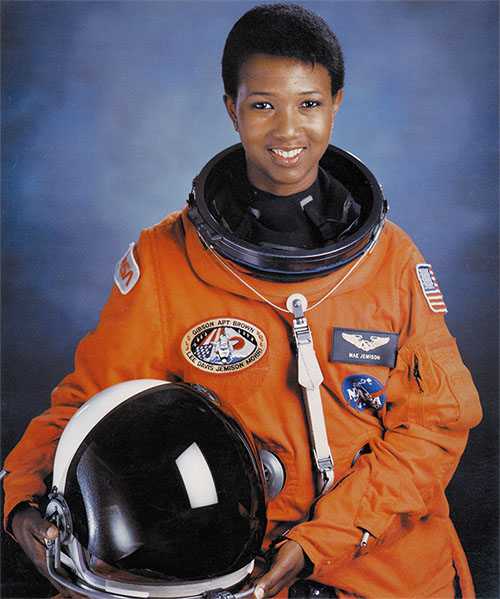
For those who think that it’s impossible and have skeptical thoughts, we would like to point out, that the first dance has already been in space in 1992. Mae Carol Jemison, American NASA astronaut made two challenges in the history: she was the first African-American woman and a first dancer to travel in space, aboard the Space Shuttle Endeavour. It was her first and only space travel with total time of almost 8 days. Jemison began dancing at the age of 11. "I love dancing! I took all kinds of dance — African dancing, ballet, jazz, modern — even Japanese dancing. I wanted to become a professional dancer… I think that people sometimes limit themselves and so rob themselves of the opportunity to realize their dreams. For me, I love the sciences and I also love the arts," says Jemison. During her senior year in college, she was trying to decide whether to go to New York to medical school or become a professional dancer. Her mother told her, "You can always dance if you're a doctor, but you can't doctor if you're a dancer". Probably that’s owing to her mother the history knows the first dancer-astronaut.
Jemison later built a dance studio in her home and has choreographed and produced several shows of modern jazz and African dance. It’s no surprise that she took poster from the Alvin Ailey American Dance Theater along with her on the flight. Even though any extra weight and personal belongings for space missions are very limited.
Knowing her passion for dancing, we truly believe that Mae Jemison definitely did perform the space dances on ship. However, we don’t have any proves for that. Probably such video is classified by NASA from the general public and probably may also be found only in Jemison’s private home video archive. May be after few years it will be unrevealed and we will be able to find this video in WikiLeaks or darknet and enjoy the first space dance moves.
And when the time will come, we believe our dance studio will also offer the highly demanded space ballroom dancing lessons that will be available in our headquarters on Earth (Dubai) and our space branches on Moon, Mars, Jupiter and major space stations. Don’t waste your time, book your lessons now! The classical choreography and classical Ballroom and Latin-American dances are the basement for all other dance styles and directions, no matter where you plan to dance later: on the ground, in the air, underwater or even in space. We will teach you the sense of rhythm, music, correct posture and dance moves. Contact us now for more information.



